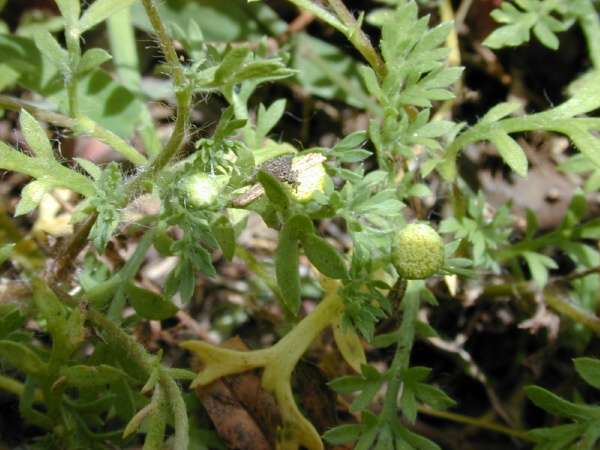
|
Family: Asteraceae |
Annuals or perennials, 2-25[-50+] cm (sometimes aromatic). Stems usually 1, erect or prostrate to decumbent or ascending (sometimes rooting at nodes), usually branched, glabrous or ± strigillose to villous (hairs mostly basifixed). Leaves usually mostly cauline [basal]; alternate [opposite]; petiolate or sessile; blades obovate or spatulate to lanceolate or linear, sometimes 1-3-pinnately [palmati-pinnately] lobed, ultimate margins entire or irregularly toothed, faces glabrous or ± strigillose to villous [lanate] (hairs mostly basifixed). Heads disciform [discoid or radiate], borne singly (peduncles sometimes dilated). Involucres broadly hemispheric to saucer-shaped, 3-12+[-15+] mm diam. Phyllaries persistent, 13-30+ in 2-3+ series, margins and apices (colorless, light to dark brown, or purplish) scarious. Receptacles flat to convex [conic], epaleate (sometimes ± covered with persistent stalks of florets). Ray florets 0 [5-8+, pistillate, fertile; corollas white] (peripheral pistillate florets 8-80+ in 1-3+ series; corollas usually none). Disc florets 12-200+[-600+], bisexual, fertile [functionally staminate]; corollas ochroleucous or yellow, tubes ± cylindric (bases sometimes adaxially saccate), throats abruptly ampliate, lobes (3-)4, ± deltate (sometimes one larger than others, usually each with central resin canal). Cypselae obovoid to oblong, ob-compressed or -flattened, ribs 2, lateral, sometimes becoming wings, faces ± papillate (pericarps relatively thin, sometimes with myxogenic cells and/or 2 lateral resin sacs); pappi 0. x = 10. Some species of Cotula are widely naturalized. F. Hrusa et al. (2002) reported Cotula mexicana (de Candolle) Cabrera as established on golf courses in California; it is similar to C. australis and differs in leaf blades mostly 1-pinnate, receptacles pilose, and disc florets functionally staminate.
Heads disciform, the outer 1-several series of fls pistillate, with short tubular cor, or rarely all the fls perfect; invol bracts slightly unequal, ca 2-seriate, membranous or subherbaceous, commonly with narrow scarious margins; receptacle naked, flat to conic; disk-fls usually fertile, with 4-toothed yellow cor; style-branches flattened, truncate, penicillate; achenes, especially of the outer fls, ±stipitate, compressed parallel to the invol bracts, commonly minutely striate, otherwise 2-4-nerved or nerveless; pappus a short crown or none; annual or occasionally perennial herbs with alternate, entire to more often pinnatifid or pinnately dissected lvs and small or medium-sized heads. 50, mainly S. Hemisphere. Gleason, Henry A. & Cronquist, Arthur J. 1991. Manual of vascular plants of northeastern United States and adjacent Canada. lxxv + 910 pp. ©The New York Botanical Garden. All rights reserved. Used by permission. |
This project was made possible in part by the Institute of Museum and Library Services [MG-70-19-0057-19].
Powered by Symbiota



